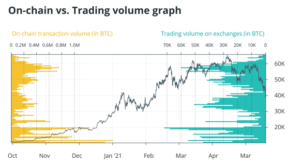Importance of Fundamental and Technical Analysis in Cryptocurrency Trading
Fundamental and technical analysis are vital trading skills due to the fluctuation of trading assets. These analyses give you information about the trading volume and patterns of different cryptocurrencies, empowering you to choose wisely. These analysis methods are often associated with traditional financial markets, but they also work incredibly well in the cryptocurrency markets.
A crucial indicator for traders when determining whether a particular cryptocurrency is worth investing in is the ratio of on-chain trading to trading volume. Tools like the relative strength index (RSI), moving average convergence divergence (MACD), and Bollinger Bands have shown to be very useful in predicting market behavior regardless of the commodity being traded. However, any professional trader will look for the following as one of their first steps: things like trading volume, support and resistance signs, and on-chain volume.
It’s crucial to comprehend what fundamental analysis and technical analysis are, the issues with using these methods in the crypto space, and how certain other metrics can be useful before delving into these metrics.
Understanding fundamental and technical analysis
To determine an asset’s intrinsic value, fundamental analysis takes into account a variety of internal and external aspects. It helps traders decide whether to join or exit a position and whether the commodity under consideration is overvalued or undervalued.
Technical analysis looks at an asset’s previous performance to forecast future price changes. The research produces useful trading data that provides insights. Technical analysis users study key indicators and spot candlestick patterns to predict the direction of future price changes.
Traditional financial analysis determines how a particular metric might perform using signals such as earnings-per-share (profit a company gets for each share) or price-to-book ratio (investors’ quotation of the company vs. its book value).
Issues with analyzing cryptocurrency initiatives
Crypto initiatives cannot conform to any prevailing practice in the industry of finance because of their distinctive differences. The closest thing to a commodity is a cryptocurrency, rather than a standard stock or bond.
Some particular cryptocurrency initiatives are based on swaps. This makes it challenging to apply current analytical tools to the crypto sphere; alternatively, We must make some minor adjustments to them to make them more compatible with the operation of digital currencies.
Finding strong metrics is the first stage in project evaluation. The metric should offer some genuine insight into the undertaking because of its strength. For example, when estimating the value of a cryptocurrency project, you cannot use metrics like the quantity of Twitter or Telegram followers. These measurements are not trustworthy because project marketers can manipulate them by buying engagement or establishing fictitious accounts.
No metric is adequate to collect every tick. You need to take into account a plethora of considerations because cryptocurrency is complicated. Therefore, you may need to combine several measures to draw a valid conclusion.
It will be better to use metrics created particularly for blockchain-based activities when analyzing a cryptocurrency project.
For instance, you could look at a blockchain’s current addresses to see if there has been an increase in usage. Even this metric, however, is not entirely obvious. Some self-interested individuals might be sending and obtaining funds to different accounts each time to establish a feeling of the abrupt incline. You can avoid such meticulous activities and improve your game by using a collection of metrics. Any such analysis will include the on-chain volume and trading volume as two important metrics.
On-chain volume: What does it mean?
You may be curious to learn how on-chain analysis benefits cryptocurrency traders. The volume of digital coins moved to exchange from other locations is referred to as on-chain volume. As these transactions are recorded on the blockchain, there are fewer cases of fraudulent transactions.
You can examine the transactions on a distributed ledger using a blockchain explorer. All of these deals are irreversible in addition to being verified and validated by a predetermined number of participants.
On-chain transactions require several steps before they are considered successful, which adds time to the process.
On a blockchain, transactions must be verified by a predetermined number of network users known as miners. A deal is regarded as honest and accurate only after the miners agreed. The transaction information is then added to the database.
What does trading volume mean?
Contrarily, trading volume reflects the amount of intra-exchange trading. These transactions take place off-chain and are documented in order books of exchanges that are reported using application programming interfaces (APIs).
Off-chain transactions, which deal with values outside of the blockchain, can be carried out using a variety of techniques, including a transfer agreement between two parties, an assurance from an outsider regarding the transaction, a code-based means of payment, or any other.
Off-chain trades don’t involve any blockchain modifications. The lack of validation results in quicker transaction time and cheaper costs. Exchanges are vulnerable to manipulation because exchanges self-report transactions that involve trading traffic. There is no network trace of an off-chain transaction because they are not recorded on the blockchain financial information, allowing room for disagreement.
On-chain volume vs trading volume: role of exchanges.
Similar to stock exchanges, cryptocurrency exchanges are essential to the cryptocurrency economy. Exchanges serve as a point of contact for traders and other crypto industry players. They perform two crucial tasks by acting as a gateway to cryptocurrencies and as a platform for money exchange.
In this context, it is not shocking to learn that the majority of blockchain activities involve exchanges where digital coins are transferred back and forth. On-chain volume and trading volume are two essential measures used to analyze the trading activity on an exchange.
The difference between the flow of funds in different exchanges is shown by the ratio between on-chain volumes and trade volumes. these discussions. When you look at the data, you learn fascinating things about the volume of trade there is on these exchanges. You won’t be able to assess the integrity of the claims without these metrics.
It will be challenging to distinguish the exchange with the largest trading volume among those with comparable user bases.
Why on-chain volume and trading volume are important metrics.
The issue of falsifying data is severe. A Bitwise research found that 95% of the volume of spot Bitcoin (BTC) trading is fraudulent. The top 81 cryptocurrency exchanges on CoinMarketCap, according to Bitwise’s analysis, recorded an average daily bitcoin volume of $6 billion. Surprisingly, only $273 million of the reported volume—or 5% of reported trading—was actually genuine.
This manipulation is to blame for the chaos in the bitcoin market. Exchanges, falsify data to climb public data aggregator rankings, such as CoinMarketCap and gain more exposure. Increased trading volume on exchanges gives the appearance of higher market activity and liquidity, which attracts new users, and fresh cryptocurrencies that want to sell.
Despite possibly bringing products for the exchanges, it does harm the reputation of the entire sector. When prospective investors notice the gaps, they might view the entire project with distrust. A metric like on-chain volume is given more significance in this situation. You can distinguish between the cheese and the chalk by comparing the volumes of digital coins that are traded through on-chain transactions.
Analysis of the on-chain vs. trading volume graph
The volume of Bitcoin traded on exchanges (green) with transactions made on-chain (blue) at various prices are compared on the graph below. On-chain trading volume is represented using Coinbase statistics, a well-known cryptocurrency exchange. Three Bitcoin metrics are combined in the graph: trading volume, on-chain transaction volume, and price across time.
On-chain vs trading volume graph
Please take notice that the volume was measured in terms of cost, not time. The graph’s lower x-axis is connected to the BTC price. The x-axis at the top of the graph corresponds to the assessment of Bitcoin on-chain volume. The graph shows how different price ranges are represented. Every time the cryptocurrency reaches a specific price level, the graph groups the amount of Bitcoin trading volume.
To correctly interpret the graphs, however, requires careful analysis; otherwise, you run the chance of interpreting the data incorrectly and ending up with the wrong results. You may have observed that both on-chain and off-chain volumes produce the same pattern, making analysis more challenging.
You can determine whether the transactions exchanges display genuinely materialized using on-chain data. Analyzing trade volume together with on-chain volume allows you to validate volume at various price points because some exchanges corrupt data to fabricate volumes. You can base your trading choices on accurate data if you carefully analyze the graphs.
Financial analysis metrics for cryptocurrencies
There are two methods for getting information out of the blockchain. Establishing a node on the blockchain and transferring the data could accomplish this, but the cost would be excessive. Using information APIs created for the purpose is a preferable alternative.
Examples include the on-chain study of Bitcoin by CoinMarketCap and the data charts from Coinmetrics.
These APIs are useful for gathering data such as on-chain volume and contrasting it with trade volume. You must consider measures like the following when analyzing on-chain metrics like volume:
On-chain transaction consideration metrics

Liquidity and volume
Liquidity, a metric of how simple it is to purchase and sell an asset, is a crucial factor to take into account when investing in any cryptocurrency. When an asset can be traded easily at market value, it is said to be liquid. Since there are many requests and bids in a liquid market, the bid-ask spread is smaller. Contrarily, an illiquid market is one in which asset owners cannot sell their possessions for a reasonable price.
A crucial sign for evaluating liquidity is trading volume. Within a predetermined time frame, you can discover trade value. You can determine the market’s interest in a particular cryptocurrency initiative by taking a quick look at the chart. Compared to assets with lower trading volumes, those with greater trading volumes are likely to be traded with greater regularity and quickly.
What constitutes a favorable trading volume?
Maintaining a fixed guideline for trading volume is impractical. Each cryptocurrency project is unique, so before making a choice, you must consider several distinct factors. When making an investment choice, indicators like trading volume and on-chain volume are given, but any clever trader will also consider other metrics.
A white paper to learn about the project’s technical, commercial, and management aspects, tokenomics to comprehend the availability of tokens, the mechanism for burning coins, market capitalization, the network value to transactions ratio (NVT), and others. To make a sound and informed choice, indicators from each of these metrics are taken into account collectively.










